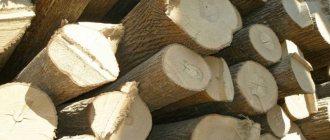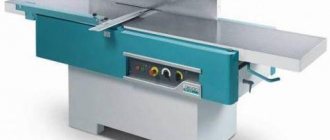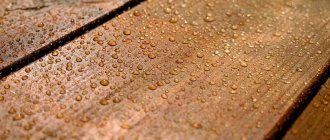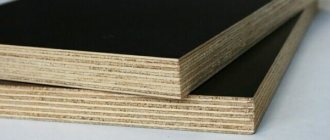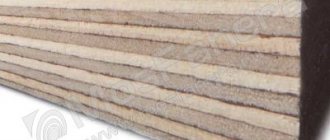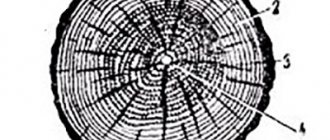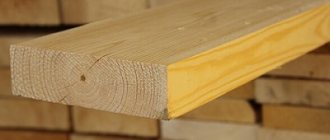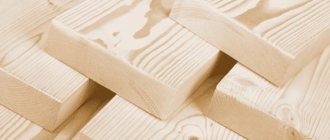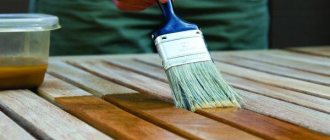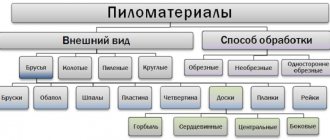Oak and larch boards, comparison
Wood is a building material that not only has excellent structural characteristics, but also has an excellent appearance and does not pose a threat to human health. Many types of trees are used to produce boards, but the best are considered to be solid oak and larch. Let's look at their features and try to help with the choice of material for construction.
Wood grade - general information, classification and regulatory requirements for lumber
In 99.9% of cases, if it is necessary to construct a wooden building, lumber is purchased in ready-made form. When choosing, it is simply vital to understand the intricacies of dividing wood into grades. This will not only help you choose the best option for each case, but in some situations it will also help you save money, for example, some sellers use double designations like AB wood grade, although this is a purely psychological technique to justify an inflated price.
Oak board
Dry oak boards have a higher density (550-750 kg/m3) and hardness compared to other species. The surface is abrasion resistant (Brunel hardness 3.7) making it an excellent material for flooring and decking. In public buildings, floors are most often made of oak. Wood is not afraid of moisture and is resistant to microorganisms, mold and fungi, due to the fact that the tannins it contains are a natural antiseptic. Constantly being in water, solid oak does not collapse, but rather increases density and hardness, improves appearance (bog oak). For structures that are exposed to precipitation, this is the best choice. Well suited for exterior decoration of buildings. A fence or building cladding made from oak boards does not need repair for several decades, even if it is not treated with special compounds or painted. Rich people used to try to build a log house using it. The price also includes oak furniture. When choosing, keep in mind that there are three types of oak wood:
- Borovaya oak (other names are oak and stone) - trees were harvested in dry places. It is distinguished by the fine-grained structure of yellow wood. The elasticity of the material is reduced, but the hardness is greater.
- Olsovy (lead, water iron) - harvesting was carried out in damp places, lowlands. The structure is large-layered with a pale pink tint. The elasticity is excellent, but the possibility of cracking is increased.
- The third type is transitional - elasticity and hardness are average between the previous types.
The disadvantages of oak boards include their higher cost than other types of wood. You also need to pay attention to the fact that due to the high density and hardness of the material, large cutting angles must be set during processing. When installing using nails, they must be lubricated.
“Ash stump” or how to distinguish ash from other wood - educational program from Sawmill
Ash stump or not ash? Let's start with the fact that the first thing you need to do to determine the type of wood is to study its end cut. This is the most reliable way to visually distinguish one wood from another, and then, if unsuccessful, you can move on to weighing, sniffing, tapping and other methods.
Ash is a ring-vascular hardwood - this means that the wood vessels form a noticeable pattern along the growth rings, as can be seen in the first photo. Porous layers alternate with denser and darker layers. For example, oak belongs to the same type, so sometimes it will be difficult for a beginner to distinguish one from the other. On the left in the photo is oak, on the right is ash
Unlike ash, oak has pronounced medullary rays, and its pores are more noticeable and larger. The diagonal stripes on the end of the oak tree that you see in the photo are the core rays
In addition, oak is most often darker and has a greenish tint to the wood, and due to the tannins it contains, it leaves a dark coating on the fingers when processed. Ash, if we summarize all attempts to describe its color scheme, is speckled gray-brown-crimson. At the end it has a soft pinkish and beige tint and glitters with silver. It can be confused with elm, but it has a more varied range of colors with a noticeable golden-green tint. Can you understand where the end of the ash tree is in the photo, and where the elm end is?
Right. On the left is ash, on the right is elm. Although they are very similar to each other. It's in the details - in the shade, in the special zigzags on the elm between the porous layers.
Sometimes ash is so striped that it can even be confused with zebrawood. It is not difficult to distinguish them - the stripes of ash are not so contrasting and do not have a brownish tint. On the left is a very striped ash, on the right is an average striped zebrawood
If, based on external signs, the ash tree still does not show itself, you can move on to more thorough methods. Ash has high viscosity, so it is difficult to process it manually. Due to the small number of core rays, ash is not prone to cracking. It does not lend itself well to painting and staining - most often this only spoils the color of ash. This is dense wood (average density from 680 kg/m3) and quite heavy - the blocks shown in the photographs weigh about 160g, and oak and elm of the same size weigh about 135g.
I hope that with this information you can easily understand which stump is an ash tree and which is not. And if you click here, you can read how we cut an end-cut cutting board made of ash and oak.
Larch
Dry larch boards are significantly superior in quality to lumber from other coniferous species. Note that it is also heavier than the more widely used pine or spruce (density 550-590 kg/m3). The material is durable and tough. Another advantage is low shrinkage and low susceptibility to warping.
Its Brinell hardness is 3.1, which is almost twice that of pine and is close to oak, so larch boards are excellent for flooring. Just like oak, the material does not lose its properties in contact with water and high humidity. Larch is excellent for constructing hydraulic structures.
Today you can find many buildings that have been based on pile structures made of this wood for more than 600 years and still do not need repair. The board does not need to be painted or treated with protective compounds, especially since the wood has a pleasant texture and a light yellow color with a hint of red. There is lumber from the so-called “bloody” larch with a predominance of red. A feature of the tree structure is the presence of multiple ingrown resin knots, but this does not affect the strength. By the way, these knots make it easy to distinguish larch from other conifers.
When choosing a board, you should pay attention to another feature of sawing wood of this species. The tree has a thick layer of sapwood, which is lighter in color and has poorer characteristics. Only the darker core is used to make boards. Sapwood wood can be used for decorative purposes.
Oak flooring
Oak flooring is valued for its attractive appearance and creates an atmosphere of cheerfulness and fullness. For a long time, oak parquet and oak floorboards were considered a sign of wealth and high status in society. Today, oak floors can only be afforded by true connoisseurs who are not looking for cheap options, but focus on reliable and noble building materials.
Oak floor lumber is quite durable and, in addition to its aesthetic and stylish appearance, has a number of advantages, including environmental friendliness, resistance to mechanical, temperature and other types of influences. Therefore, an oak floor board is not only a chic option, but also quite practical.
Solid boards remain popular. It is large in size and used for large areas, and also has a much higher cost. When laying tongue-and-groove solid oak boards, it requires additional effort due to its heavy weight. It is worth noting that thanks to its appearance, massive floors have regained the lost position of natural wooden floors. It must be, like any of them, stable due to its great weight and strength.
Bleached oak boards allow you to create a bright atmosphere in your home, filling it with bright colors and soft light. Sometimes designers combine oak and beech to create a more varied and lively interior. The combined flooring can also include ash boards. Added ash dilutes the color scheme with fresh pastel tones.
Its disadvantage is that ash is not as stable as regular edged oak and beech.
Characteristics of wood
Oak wood is distinguished by its strength, strength, density of 720 kg/m3, hardness and heaviness.
An oak lives on average 1000 years. The trunk diameter can exceed 2 m. The older the tree, the higher the quality of its wood.
Our ancestors built wells from oak wood - the water in them did not “bloom”, it was cold and clean. In peasant farming, an oak table and an oak mortar were considered the best. Rims and runners were bent from oak, barrels, tubs, and bowls were made. Oak piles were also driven into the river.
Oak wood is very durable and difficult to cut. It bends well. It has a beautiful coarse texture. Easy to paint. When cut radially, the texture of an oak board is very beautiful. When processed with a chisel, it is fragile, requires a hard and sharp tool and caution, and withstands large threads well. For joinery it is necessary to use oak aged 150-200 years.
Peculiarities
Oak board is a natural building material that has earned an honorable place in the market due to its advantages and unique properties. The presence of a rich natural texture allows us to produce products that acquire a noble appearance, and therefore can fit into any interior. For example, oak plank flooring looks stylish and aesthetically pleasing, and the same goes for furniture designs. It is important to note the resistance of the material to stress. It is scratch resistant and no defects appear on the surface due to mechanical damage.
Oak is considered one of the most durable species, which attracts builders and manufacturers of furniture structures. Even unfavorable atmospheric conditions will not affect the properties of the material, which undergoes careful treatment with products, so its physical functions are preserved for many years.
The big advantage of the material is its moisture resistance; the board will not absorb water, so the structure will not be damaged, and this is extremely important when it comes to outdoor and outdoor structures. Long service life is also a big advantage of this building material. It is worth noting that oak boards are environmentally friendly, so you can use them to make children’s furniture and create any products without harm to health and the environment. Working with the material is easy and simple; it can be easily cut and sawed, despite the density of the structure and the high hardness of the rock. Many are attracted by the ability to perform artificial aging, which gives wood an amazing effect.
As for color, there are no problems with this, since the wood can be repainted from a dark to a light shade, choosing any solution.
The building materials market offers a wide range of oak boards; each classification has its own characteristics and advantages, which are useful to familiarize yourself with.
Edged boards are cleared of bark and various knots at the processing stage. The end and wide parts are mechanically cleaned and done very carefully. As a result, products made from this material become durable and have an impressive appearance. There are many areas of application for such boards - flooring, finishing work, furniture industry, construction of staircases, etc.
There is also an unedged board that is processed on both sides. It is a rough material best used in carpentry, construction and furniture making. The boards make strong frames, fences, stools and roofing structures.
Dry board is one of the most common types of lumber. It goes through a drying process in chambers for several weeks, depending on the thickness of the product. This is a valuable industrial raw material that is used to create flooring, partitions and in furniture production. It is important to note that products made from such material are less affected by fungus and mold, so they will not need to be processed additionally.
However, drying should only be done by professionals, since the desired effect cannot be achieved at home.
Universal lumber is planed dry board, which is subjected to high-quality processing not only on the end side, but also on all the others, which is why it is called polished. The main features of the product are its smooth surface, correct geometry and wear resistance. With this material you can make a stylish and durable facade cladding, build a fence and gazebo, produce false beams, decorative beams, etc.
Planed calibrated boards have a beautiful, aesthetic appearance, but their main advantage is functionality. The material undergoes deep processing using professional equipment, so the accuracy of the fit is guaranteed.
Thanks to this, the frame made from such a board will be as reliable as possible, and this is important.
Ash
The density of wood is 690 kg/m3.
Ash is a genus of deciduous plants of the olive family, which has about 70 species. Ash grows singly or in groups in mixed forests, often together with oak, less often with conifers.
This is a modest neighbor of the oak tree, which for some reason has not become so famous, although it deserves all sorts of praise. Not inferior to it in strength and hardness, richness of texture, it is significantly superior to it in long-term resistance to deformation and impact strength. Therefore, it is ideal for the manufacture of stairs, flooring and other interior details. Currently, ash is increasingly becoming fashionable among furniture makers and parquet manufacturers. Regarding consumer qualities, we can say that ash, with standard care, lasts a long time and does not present any surprises. The cost of products made from it is close to the cost of products made from oak and beech.
Advantages and disadvantages
The main advantage of wooden cutting boards is environmental friendliness , because natural wood is used for their production. But this in no way applies to those products that are made from sawdust and glue, like plywood. According to the standards, no chemicals or substances hazardous to human health should be used in production. The manufacturer must comply with all regulations and guarantee absolute safety. However, it is worth considering that the cheapest products are hardly manufactured according to standards; they are often simply riveted together in some basement. Therefore, it is better to overpay a little, but be sure of the quality of the product.
In addition to being environmentally friendly, kitchen wooden boards are distinguished by such important performance qualities as wear resistance, long service life and reliability.
Despite its many advantages, wood as a material has a number of disadvantages. High-quality wood has a fairly high cost compared to the same plastic or glass. In addition, wood is susceptible to absorbing odors and moisture. Such products require special care . They are relatively heavy and do not tolerate prolonged contact with moisture .
Larch
The density of Siberian larch is 620-725 kg/m3 with a humidity of up to 12%.
Larch is a genus of woody plants of the pine family, one of the most common species of coniferous trees. This is the only genus of conifers whose needles fall off in the winter.
Larch wood is characterized by increased strength compared to oak. In addition to special strength and resistance to external influences, it is characterized by good color and structure.
Possessing high physical and mechanical properties, at the same time it requires a certain technological approach when processing it. Saw blades become heavily oiled when sawing. It is difficult to process with ordinary tools, but can be sanded and painted well. Prolonged exposure to water leads to a noticeable increase in hardness.
The cost of products or structures made from larch is higher than from pine, but the products are much more durable.
Coniferous timber, edged and unedged wood according to GOST
Looking at GOST 8486-86, you will see that the requirements for edged timber differ from the requirements that unedged softwood timber must meet. You can find the following items in it:
- The length of the coniferous timber should be from one to six and a half meters and can be specified depending on the purpose of the wood.
- For beams intended for different purposes, different parameters are set in terms of thickness in millimeters.
- GOST also indicates that the quality of timber is divided into five main grades: selected, first, second, third, fourth and fifth. Selective is timber of the highest quality, while fifth grade is wood that can only be used for technical and industrial purposes.
- The quality of softwood timber should be assessed based on the worst side or edge of an individual timber. The quality of edged timber will differ from the quality of unedged timber.
Pine
Pine density is 520 kg/m3.
Pine is distributed throughout northern Russia and most of Siberia and forms both pure forests and forests mixed with spruce and other trees.
Pine lives up to 600 years and in adulthood reaches a height of 30-40 m. Its trunk is straight, even, and easy to plan and saw. Pine wood is sound, resinous, and low-elastic. Depending on the characteristics of the growing conditions of the tree, the density and specific gravity of the wood may vary. Scots pine is distinguished by wide sapwood, which cannot be removed. Therefore, in warm weather and the sapwood thickening, which occurs from spring to autumn, the log may turn blue. Surface blueness can be observed even in well-ventilated wood piles. Blue stain does not change the mechanical properties of wood, so it can be successfully combated. For these purposes, the industry produces a number of drugs.
Pine wood is soft and easy to work with, and does not crack when dry. Thanks to its beautiful color and clearly defined texture, it is widely used in the production of carpentry, in the production of artistic carvings and turning products.
The average density of spruce wood at a standard humidity of 12% is 445 kg/m3.
The total area of spruce forests in Russia is about 70 million hectares. Spruce lives 250-300 years.
The spruce wood is white, with a slight yellowish tint, and low in resin. Spruce is a low-density species. In terms of strength properties it is somewhat inferior to pine. It bends somewhat better than pine wood.
Spruce is a tree that is exceptional in its properties. One of these properties is musicality. Since ancient times, I have been making musical instruments from spruce, including stringed instruments. Novgorod harps of medieval Rus' were most often made from spruce. The wood is soft, light, and is used as a building material (boards, beams), for small crafts, and for processing into wood pulp. Used for the production of wood chemical products - paper, cardboard, cellulose. It is also used in ornamental gardening and park construction.
Oak or ash - which is better for parquet boards
Oak and ash are most often used in the production of parquet boards. These traditional woods are classic materials for durable and aesthetically pleasing flooring. But what is better to choose: ash or oak? This question is often asked by buyers.
Or maybe exotic is better?
Some parquet connoisseurs recommend making an alternative choice: ordering flooring from an exotic species. Nowadays such wood is very popular and in demand. Parquet boards with a top layer of rosewood, teak, merbau, mahogany, wenge, iroko and other exotic species are distinguished by their rare beauty, durability, and increased resistance to moisture and temperature changes. But it is quite difficult to advise choosing these species instead of oak or ash. Firstly, there are people who prefer restrained European classics rather than bright tropical luxury. Secondly, flooring made from rare exotic species is very expensive, while oak and ash are much more affordable.
Therefore, for those who are interested in these two traditional breeds, we will name the characteristics of each of them.
Advantages:
- The density of oak wood is on average 750 kg/m3. Wood has high moisture resistance, so oak parquet boards can even be laid on a balcony or loggia, in the kitchen and bathroom. Wood is highly resistant to rot, mold and mildew.
- Oak hardness according to Brinell is 3.7. This is a high indicator with which the hardness of other rocks is usually compared. Withstands heavy loads. In order to damage an oak parquet board, you need to try very hard.
- Oak wood has many beautiful shades, both dark and light. Noble smooth texture. Oak parquet fits into almost any style and color scheme.
- The tree withstands various types of processing well. With the help of tinting, bleaching, staining, and brushing, an oak board can be turned into a masterpiece of design art.
Flaws:
- Such a valuable quality of oak as high hardness can sometimes be a disadvantage. Laying oak parquet is a rather labor-intensive process. Therefore, if you do not have special skills, we recommend that you seek the services of a professional.
Ash
Advantages:
- The density of ash is 700 kg/m3. This is very close to the value of oak (750 kg/m3). The wood is durable and resistant to negative influences.
- The hardness of ash is even higher than that of oak - 4.1. This parquet can withstand maximum loads. Suitable for large formal spaces where a high performance floor is needed.
- Ash has higher elasticity than oak. Withstands various processing methods. Ash parquet is easier to install than oak.
- It has a wide range of expressive warm shades. Ash has sunnier and brighter tones than oak. The texture of ash is coarser. Over time, the wood darkens; we recommend taking this property into account when choosing a color.
Flaws:
- Ash is less resistant to changes in temperature and humidity than oak. Does not like direct exposure to moisture and is more susceptible to mold. It is better not to install ash parquet boards in the bathroom, kitchen or balcony. More delicate ash wood dries out when overheated. Therefore, it is necessary to maintain an optimal temperature level in the room.
Conclusion
Both species - oak and ash - are excellent materials for making parquet boards. Their cost is approximately the same, both breeds have high performance properties. The choice between them depends on the specific tasks and conditions of the room, as well as personal aesthetic preferences.
Parquet boards made of oak and ash are presented in the best collections of global and domestic manufacturers. These are Par-ky, Goodwin, Focus Floor and other well-known brands.
HoltzCom Hardwood Lumber Specifications
These Technical Specifications define: the requirements for the quality of lumber and furniture panels for valuable wood species, used in the trade turnover of the Kholtsky company.
- The lumber board is oak, the board beech can have an arbitrary step of length and width (“varied lengths and different widths”). Within the specified standard sizes: “Board D1” length from 500 mm to 999 mm, width from 75 mm and above.
- “Board D” length from 1000 mm to 1999 mm, width from 80 mm and above.
- “Long board” length from 2000 mm and above, width from 100 mm and above.
- Solid shield - lamellas are spliced only in width from 1000 to 2400
- Spliced shield - lamellas are spliced both in length and in thickness
- Defects are considered to be shortcomings of individual sections of wood that reduce its quality and limit the possibility of its use.
- Defects are considered to be defects in wood of mechanical origin that arise in it during the process of harvesting, transportation, sorting, stacking and mechanical processing.
- The grade of lumber is determined by the worst face and edge. The worst face of lumber is considered to be the face with the largest number of grade-determining wood defects and their largest dimensions or with the worst quality of processing.
- For different types of wood, different grade-determining defects are introduced that are applicable specifically to this type of lumber. In this case, the following positions are highlighted: Defects permissible on grade A surface
- Defects allowed on grade B surface
- Other defects not included in A and B are not allowed or are determined by a separate class.
- Grade A (other names - grade-0, extra) involves two layers with defects acceptable for grade A (the first layer is quality A and the second layer is quality A). At the same time, for various types of lumber, defects are introduced that are allowed for the grade A face of this species.
- The humidity of the dry board should be 8% +/-2%
- The board must be dried in a “soft mode”; the presence of external and internal sections is not allowed. Uneven distribution of moisture across the board and residual unrelieved stress in the board are not allowed.
- All boards in the batch must have the correct geometric sawing shape - there should be no deviations from the parallelepiped shape (taper, bevel of the cut, “wave” in thickness, etc.).
- On individual boards (no more than 8% of the batch volume), wane “for processing” is allowed (approach to the surface no more than 5 mm)
- Planed lumber is considered lumber that has at least one face or both edges processed by planing.
- Calibrated lumber is lumber that has been dried and processed to a specified size.
- Fused knots are knots whose annual layers have grown together with the surrounding wood over at least 3/4 of the perimeter of the knot's section.
- Healthy knots are knots with wood without signs of soft rot.
- Light healthy knots – healthy knots whose wood is close in color to the surrounding wood
- Rotten knots are knots with soft rot, occupying more than 1/3 of the cut area of the knot.
- Tobacco knots are rotten or rotten knots in which the rotted wood is completely or partially replaced by a loose mass of rusty-brown (tobacco) or whitish color.
- Longitudinal warping along the face (“ski”) is allowed no more than 2.5% per linear meter of length
General information about lumber
The term “lumber” covers a whole range of different products, from slabs to beams, which can easily be used as load-bearing structural elements. Before you begin to closely study the grade of wood, it will not be superfluous to understand the classification of lumber (see also the article “Do-it-yourself wooden gazebo: main points”).
Classification can be performed according to a number of criteria.
For example, by assortment you can distinguish:
- croakers;
- beams and beams;-
- both sexes;
- sleepers;
- boards of various thicknesses - these lumber are especially popular; almost no DIY construction project can do without them.
The list of types of lumber is quite large
If we take the processing method as a basis, then we can distinguish the following types of lumber:
- trimmed and non-faceted. In the first case, cutting to length occurs, in the second - not;
- with different processing methods. Calibrated lumber is lumber not only dried to a given moisture content, but also processed taking into account the required dimensions, planed - at least 2 edges or 1 plane must be processed by planing, lumber can also be produced edged, single-edged and unedged;
- Based on strength, a separate class of structural lumber is distinguished. Hardwoods are used for production.
Note! Only hardwoods such as oak, larch, etc. are used as structural lumber.
Limit on number of defects
Types of boards
Currently, lumber manufacturers offer two types of boards: edged and unedged. We use both types of boards in the production of wooden containers; the range can be found in the Product catalogue.
The edged board has a regular rectangular shape and is a single piece of wood, even along the edges and cleared of bark. The level of bark removal and the degree of processing are determined by the required grade of edged boards. Such a board can be used in production without additional processing.
An unedged board is made by sawing an untreated log in such a way that the board is smooth on both sides, and rounded untreated areas covered with bark remain on the sides. This type is 2-3 times cheaper than edged and is used mainly for the manufacture of wooden boxes whose appearance is less important.
Types of oak
In carpentry, the following classification of oak materials is used:
- Stone. Plantings of this wood grow on sandy soils. Materials obtained from such trees are hard, but have low elasticity. The boards will be light in color, the layers will be fine, and the bark will be thick.
- Iron. This is the name given to oak that grows on moist soils, near water bodies and in alder forests. This material has a lot of weight and elasticity. But the raw material is quite capricious; it is difficult to process it without damaging it. This is precisely why lumber and iron oak products are very expensive.
- Intermediate. These trees grow in mixed areas. The board will have a yellowish tint, but the structure is rich and original.
Types of boards
The main criteria for dividing into grades are moisture, deformation during drying, clear dimensions, the presence of knots and other irregularities. There are 5 grades in total, ranging from selected “Lux class” boards to “E” class wood scraps.
Grade 0 is used mainly in shipbuilding and automotive production. Grade 0 boards are used to make the “sides” of trucks, interior elements of car interiors and cabins, deck boards, and masts for yachts. The main requirements are that large knots are visible, no more than 2 meters at a distance from each other. Rotten knots and parts of wood are not allowed. The presence of cracks should not exceed 10%, mainly formed as a result of shrinkage. The wood must not contain parts of the root system, the lumber must be clean.
1st grade is used in furniture production and industry. Rotten and falling out knots more than 10 mm, through cracks more than 1 mm deep and ¼ of the length of the board are not acceptable. There should be no elements of rotten wood, as well as elements of “dead” bark or an overgrown wound. Rottenness, elements that are gray in color, mold or inclusions of foreign parts are not acceptable. This type of board is used in the production of wooden gift boxes.
Grade 2 is also used in furniture production, but in closed areas, such as frames. Not allowed: falling out or rotten large knots larger than 20 mm, cracks 1 mm deep and 1/3 of the length of the board, rottenness, rotten places, places infested with parasites. Foreign objects and damage are also unacceptable. Wood “defects” that do not spoil the general characteristics and appearance are allowed for this grade.
Grade 3 is considered low-level wood, but also with a very low price. It is used mainly in the packaging industry, usually in disposable boxes, transport packaging and other wooden packaging where appearance is not so important, but large intergrown knots and end cracks throughout the entire depth are not allowed. Almost all other defects are acceptable, even rotting and damage to the wood layer and sharp bends of the fibers. As a rule, boards of the 3rd grade are scraps from the first and second grades of lumber.
Grade 4 is the lowest and is used for the construction of temporary fences at construction sites, formwork for foundations, when installing scaffolding, temporary buildings, sheds and similar structures. All possible defects are allowed here: rot in the amount of 10% of the total area, wane can be blunt or sharp, “warped” and “winged”.
General technical requirements
To determine the grade of edged and unedged lumber, there are generally accepted state standards.
Regulatory Requirements
Wood producers rely on the regulatory framework, which is regulated by such documents as GOST 24454-80, GOST 8486-86, GOST 2140-81, etc. All documentation is freely available, but some meanings are still incomprehensible to people far from the construction industry.
Since mostly softwood lumber ends up on construction sites, GOST 8486-86 is considered the most basic document.
Key excerpts worth paying attention to:
- Boards and bars are divided into 5 grades, bars - into 4.
- Wood moisture content should be no more than 22%. Drying wet wood is almost impossible.
- The roughness value parameter is set to 1250 microns, and for grade 4 - 1600 microns.
- The nominal length of the product should be 1.0-6.5 m, and deviations from it should be from -25 mm to + 50 mm.
GOST 8486-86 Softwood lumber. Specifications
The grade of products is strongly influenced by the criterion for limiting natural wood defects. The general list of required parameters according to GOST is more than 30 items.
Norms and restrictions of natural vices
Each type of wood has its own standards and restrictions on natural defects. These characteristics are given in GOST in the form of a table.
GOST 24454-80 Softwood lumber. Dimensions
Excerpts from the regulations:
- Tree knots are divided into healthy, rotten, edge, and partially fused. Each type of wood has a strictly regulated number of knots.
- The slope of the fibers for the highest grade should not exceed 5%, otherwise the wood will be assigned grade 1.
- For selected wood, the presence of rot, mold, wormholes, fungal and cancer spots and foreign inclusions is unacceptable.
GOST 2140-81 Visible defects in wood. Classification, terms and definitions, methods of measurement
There is also such a parameter as longitudinal warpage, which should be up to 0.20% of the width of the lumber.
Processing principles and application
Carpentry involves the use of hardwood in most cases. Oak takes a leading position in this regard. In addition to its positive physical qualities, there is also a wide range of shades of the material, a beautiful and unusual fiber structure. Oak wood in its finished form bends well and is not susceptible to rotting or exposure to biological pests. The wood has a porous texture, high viscosity, and is easy to process. But in the manufacture of any items, difficulties may arise due to all sorts of defects: knots and large knots.
Possible reasons for restricting access:
Access is limited by court decision or on other grounds established by the legislation of the Russian Federation.
A network address that allows you to identify a site on the Internet is included in the Unified Register of domain names, page indexes of Internet sites and network addresses that allow you to identify sites on the Internet containing information the distribution of which is prohibited in the Russian Federation.
A network address that allows you to identify a site on the Internet is included in the Register of domain names, indexes of pages of sites on the Internet and network addresses that allow you to identify sites on the Internet containing information distributed in violation of exclusive rights.
Where is oak wood used?
Summer oak wood is widely used in construction, and its moisture resistance properties allow it to be used in underwater structures or the hulls of wooden floating craft. It is also good for making souvenir crafts.
Winter wood is used in carpentry, furniture and parquet production. Oak firewood is not the best option because coal cools quickly. And to maintain combustion you need good draft. And it’s a pity to use such valuable wood as fuel, unless waste from other industries can be used for firewood.
Buying beech boards: where to buy
Where to buy beech boards? On the website you can familiarize yourself with the range of products, among which the desired option is present. To buy beech material for construction, you must fill out a “quick order” form, which indicates the quantity of lumber.
Beech boards at retail: you can buy the product individually by indicating the required number of boards in the appropriate sector. If you have any questions about the delivery of piece goods, you must contact a company specialist by email or phone.
Caring for Wooden Cutting Boards
In order for a cutting board to serve for a long time, it is necessary to provide it with some care. As soon as the product is purchased, it is worth wiping it with mineral or linseed oil. It is advisable to carry out this procedure several times to obtain a high-quality protective layer.
After each cooking, the board must be washed. This will give you the opportunity to get rid of unpleasant odors. This procedure is done using vinegar, lemon juice or plain running water. It is advisable not to use detergents so that they do not subsequently enter the human body.
It is advisable to store the boards in an open place and not put them in boxes. The air must constantly circulate to prevent mold and unpleasant odors. It is advisable to purchase several cutting boards for different groups of products: fish, meat, fruit, baked goods.
